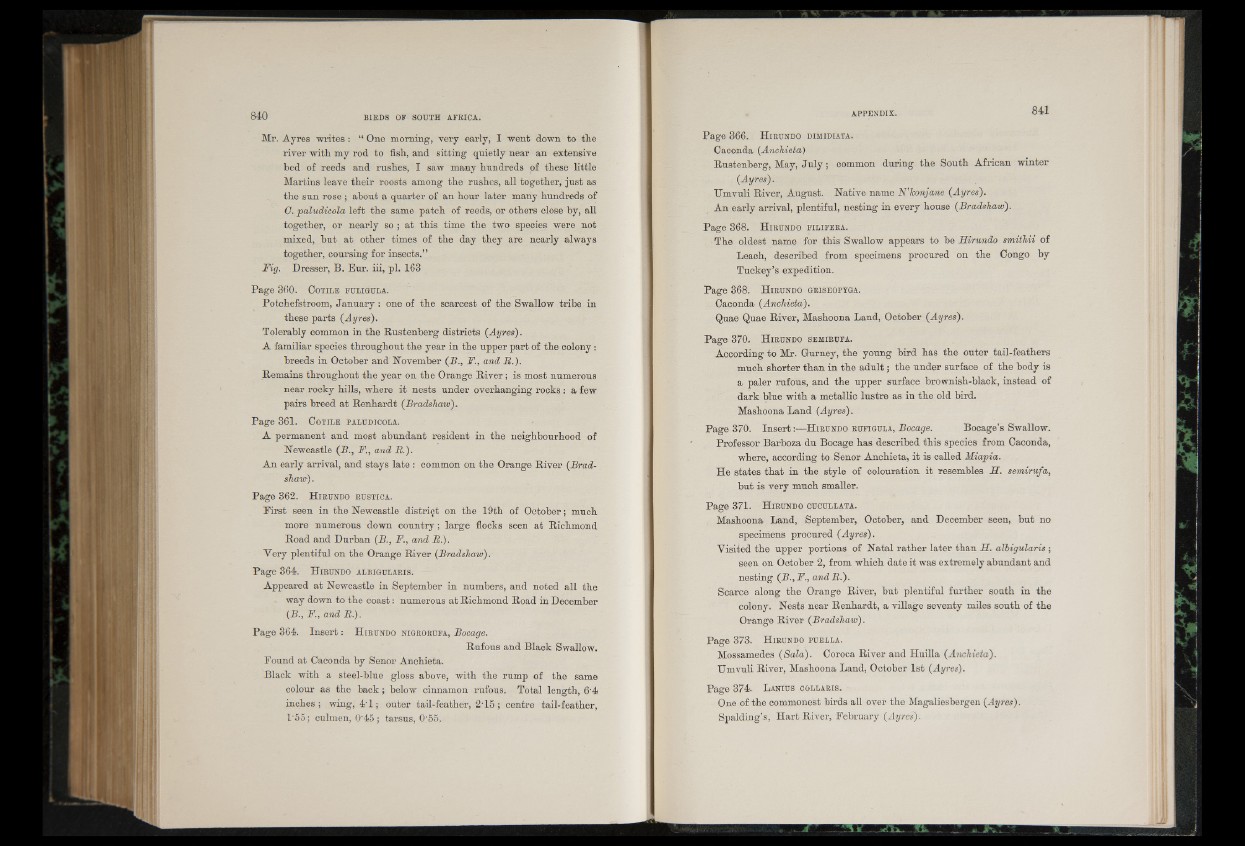
Mr. Ayres writes : “ One morning, very early, I went down to the
river with my rod to fish, and sitting quietly near an extensive
bed of reeds and rushes, I saw many hundreds of these little
Martins leave their roosts among the rushes, all together, just as
the sun rose ; about a quarter of an hour later many hundreds of
G. paludicola left the same patch of reeds, or others close by, all
together, or nearly so ; a t this time the two species were not
mixed, but at other times of the day they are nearly always
together, coursing for insects.”
Fig. Dresser, B. Eur. iii, pi. 163
Page 3 6 0 . C o t i l e f u l i g u l a .
Potchefstroom, January : one of the scarcest of the Swallow tribe in
these parts {Ayres).
Tolerably common in the Rustenberg districts {Ayres).
A familiar species throughout the year in the upper part of the colony:
breeds in October and November {B., F., and Jt.).
Remains throughout the year on the Orange R iv e r; is most numerous
near rocky hills, where it nests under overhanging rocks : a few
pairs breed a t Renhardt {Bradshaw).
Page 361. C o t i l e p a lu d ic o la .
A permanent and most abundant resident in the neighbourhood of
Newcastle {B., F., and B ).
An early arrival, and stays late : common on the Orange River {Bradshaw).
Page 3 6 2 . H i r u n d o r u s t i c a .
First seen in the Newcastle district on the 19th of October; much
more numerous down country; large flocks seen at Richmond
Road and Durban (2?., F., and 22.).
Very plentiful on the Orange River (Bradshaw).
Page 364. H i r u n d o a lb i g u l a r i s .
Appeared a t Newcastle in September in numbers, and noted all the
way down to the coast: numerous a t Richmond Road in December
(B., F., and 22.).
Page 364. In s e r t: H i r u n d o n ig ro ru p a , Bocage.
Rufous and Black Swallow.
Found at Caconda by Senor Anchieta.
Black with a steel-blue gloss above, with the rump of the same
colour as the b a ck ; below cinnamon rufous. Total length, 6'4
inches ; wing, 4 T ; outer tail-feather, 2T5 ; centre tail-feather,
1'55; culmen, 0'45; tarsus, 0'55,
Page 366. H i r u n d o d im id ia ta .
Caconda (Anchieta)
Rustenberg, May, J u ly ; common during the South African winter
(Ayres).
Hmvuli River, August. Native name N'konjane (Ayres).
An early arrival, plentiful, nesting in every house (Bradshaw).
Page 368. H i r u n d o p i lip e r a .
The oldest name for this Swallow appears to be Hirundo smithii of
Leach, described from specimens procured on the Congo by
Tnckey’s expedition.
Page 368. H i r u n d o g r is e o p tg a .
Caconda (Anchieta).
Quae Quae River, Mashoona Land, October (Ayres).
Page 370. H i r u n d o s em iru f a .
According to Mr. Gurney, the young bird has the outer tail-feathers
much shorter than in the a d u lt; the under surface of the body is
a paler rufous, and the upper surface brownish-black, instead of
dark blue with a metallic lustre as in the old bird.
Mashoona Land (Ayres).
Page 370. In s e rt:—H i r u n d o r u p ig u la , Bocage. Bocage’s Swallow.
Professor Barboza du Bocage has described this species from Caconda,
where, according to Senor Anchieta, it is called Miapia.
He states th a t in the style of colouration it resembles 22. semirufa,
but is very much smaller.
Page 371. H i r u n d o c u c u l l a t a .
Mashoona Land, September, October, and December seen, but no
specimens procured (Ayres).
Visited the upper portions of Natal rather later than 22. albigularis ;
seen on October 2, from which date it was extremely abundant and
nesting (B .,F ., andB.).
Scarce along the Orange River, but plentiful further south in the
colony. Nests near Renhardt, a village seventy miles south of the
Orange River (Bradshaw).
Page 373. H i r u n d o p u e l l a .
Mossamedes (Sala). Coroca River and Huilla (Anchieta).
Hmvuli River, Mashoona Land. October 1st (Ayres).
Page 374. L a n iu s c o l l a r i s .
One of the commonest birds all over the Magaliesbergen (Ayres).
Spalding’s, Hart River, February (Ayres).